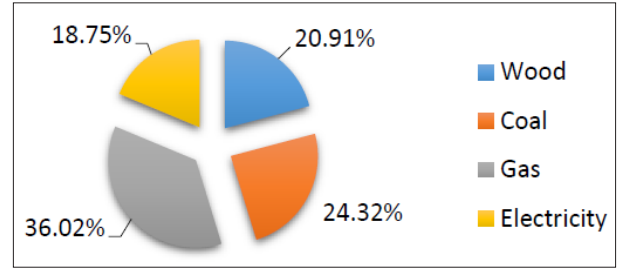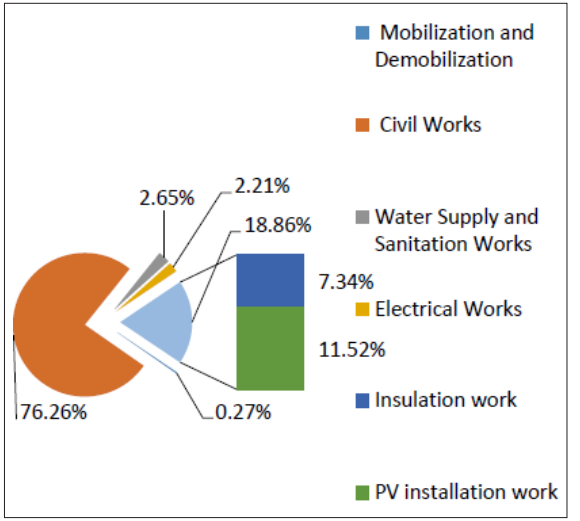Design of Typical Energy Efficient and Zero Energy building for Kabul City
© 2022 Ahmad Masih Ahmadi, et al. This is an open-access article distributed under the terms of the Creative Commons Attribution License, which permits unrestricted use, distribution, and reproduction in any medium, provided the original author and source are credited.
Abstract
Recently, the consumption of energy in residential buildings has been increasing. On one hand, urbanization increased energy consumption in residential buildings. On the other hand, construction of nonstandard buildings especially residential buildings, caused excessive energy waste. Implementation of energy efficiency and zero-energy building strategies is one of the best solutions to decrease energy waste and energy intensity in a residential building in Kabul City. This research is conducted to design typical energy-efficient and zero energy building strategies for Kabul City. The majority of people use unrefined fossil fuels for heating. As we know, fossil fuels cause environmental pollution. To burn these fuels, most greenhouse gases GHGs emissions are released in the atmosphere, and these GHGs are very harmful to health and cause different types of illnesses. This study is performed in two stages. First, the construction cost of a customarily built building is calculated. Then, the heat loss and heat gain of this inefficient building are also calculated. The same procedure is repeated for a more efficient and insulated building. After comparing, it is revealed that an insulated building saves 65% of the energy and emits 60% less CO2 compared to the inefficient building. To make this building a zero-energy building, we tried using photovoltaic technology. All-electric loads for this building are calculated, and the components of the photovoltaic system are designed accordingly. Finally, the implementation of energy-efficient and zero-energy building has lots of benefits of cost-saving, being environment-friendly, reduced illness, and individual sustainability for each building.
Introduction
As a matter of fact, majority of the constructions in Afghanistan lack energy and power infrastructures. Likewise, most of Afghan citizens struggle in providing basic needs, they remain cold in winter also often experience indoor air pollution as result of fuel consumption. Furthermore, it is stated that in in 2013-2014, residential and commercial buildings in Afghanistan consumed about 74 % of the electrical energy supplied by (DABS). As it was consumed for different purposes such as: space heating, cooling, lighting, cooking, water heating, refrigeration, gadgets and other human needs.
Nowadays, constructions in Kabul are built with low quality with lower initial price. Since most of the maps are being adopted foreign countries and people are willing to use them because of their lower price without considering the field specifications like temperature and humidity. On the other hand, the construction companies try to finish their task as cheaper as possible, their aim is just to design a cost- effective project thus, they do not even think of the amount of energy that will be used for heating or cooling the buildings. Therefore, for addressing the aforementioned challenges facing Kabul citizens, this research has been conducted on energy efficiency and zero energy buildings for addressing one of the three floor building that is located at Kabul city.
Energy Efficiency
Energy efficient buildings are defined as buildings that are designed to provide majority amount of reduction of the energy want for heating and cooling, severally of the energy and of the equipment’s which will be chosen to heat or cool the building [1].
Zero Energy Building
A zero energy building (ZEB) produces enough renewable energy to satisfy its own annual energy consumption needs, thereby reducing the utilization of non-renewable energy within the building sector [2].
Methodology
Today’s buildings in Kabul city are not standard and the annual energy consumption reaches to very high level. According to survey, most of Kabul citizens use fossil fuels for maintaining air indoor comfort in winter which this leads to generating toxic gases in the air. Although these gases have bad effects on environment, human health, agriculture and ground water. This research considered one of the typical building which is located in Qalah-Fatih-Ullah with 240 square meter area. For design, the typical energy efficient and zero energy building for Kabul city, all estimation and design divided in to case.
Case 1 (Inefficient Building)
All design conduct with primary materials and traditional materials that construct a building in Kabul city.
Case 2 (Efficient Building)
All design conduct with primary materials additional insulation materials and renewable energy for a building in Kabul city.
In case 1, estimation of the building which the total amount of this cost estimation is 15,264,084 AFN. Consequently, the amount of heat loss and heat gain of this building is calculated as 89 KW (heat loss) and 49.7 KW (heat gain) [3]. According to survey from Kabul citizens, people use variety of heating resources such as 20.91 % wood, 24.32 % coal, 36.02 % gas, and 18.75 % electricity.

Figure 1: Percentage of Kabul Citizen to Use for Heating
Therefore, the amount of budget for heating expenses is calculated as188,577 (AFN/ year) which will generate 5.3 (Ton/year) CO2 from combustion of these resources for one of the inefficient building in Kabul city. Due to the environmental impact of toxic gasses and high annual energy cost of these buildings.
In case 2, to add insulation material in external walls, floor and roof. By adding such material, the amount of heat loss decreases to 28 KW and also the amount of heat gains decreases to 18.38 KW, also this material could reduce the amount of 1.67 (Ton/year) GHGs and could save annually 59,540 (AFN/year) cost of energy [4]. The total amount of insulation materials shown in below table:
Table 1: Calculation the Cost of Insulation Material per Square Meter
|
East |
|
|
|
|
|
|
|
North- West |
6 |
10 |
36.1 |
1,800 |
3 |
194,670 |
|
South -East |
6 |
10 |
38.1 |
1,800 |
3 |
205,470 |
|
South -West |
6 |
10 |
30.4 |
1,800 |
3 |
164,214 |
|
Stair Walls |
||||||
|
North-East |
6 |
10 |
9.0 |
1,800 |
3 |
48,600 |
|
North-West |
6 |
10 |
15.3 |
1,800 |
3 |
82,620 |
|
South-East |
6 |
10 |
15.3 |
1,800 |
3 |
82,620 |
|
South-West |
6 |
10 |
9.0 |
1,800 |
3 |
48,600 |
|
Floor |
3 |
15 |
238.9 |
800 |
1 |
191,087 |
|
Roof |
3 |
20 |
238.9 |
800 |
1 |
191,087 |
|
Total |
1,382,363.2 |
|||||
In addition, for making zero energy building, feeding electric energy from solar energy with photovoltaics technology which electric consumption of appliances were calculated and designed the components of photovoltaics system. The initial cost of this technology is high but the annual energy production is substantial and also it is friendly with environment. For maintaining indoor comfort in buildings, there is need for heating in winter use from fossil fuels and the combustion of these resources emitted GHGs, lots of these resources reduced with energy efficiency and the amount of reaming resources will zero with photovoltaics system and also this technology prevent GHGs emission. The total cost of photovoltaics systems shown in below table [4]:
Table 2: Total Cost of PV System
|
Total PV Cost |
|
|
|
Equipment |
15,302 |
$ |
|
HVAC |
10,875 |
$ |
|
Cables |
225 |
$ |
|
Smart meter |
2,400 |
$ |
|
Total Cost |
28,802 |
$ |
|
Total Cost |
2,160,150 |
AFN |
The initial cost of each works shows in below table:
|
Total implementation cost |
|||
|
No. |
Types of work |
Cost |
Unit |
|
1 |
Mobilization and Demobilization |
50,000 |
AFN |
|
2 |
Civil Works |
14,303,167 |
AFN |
|
3 |
Water Supply and Sanitation Works |
496,783 |
AFN |
|
4 |
Electrical Works |
414,134 |
AFN |
|
5 |
Insulation work |
1,382,363 |
AFN |
|
6 |
PV installation work |
2,160,150 |
AFN |
|
Total Cost |
|
18,806,597 |
AFN |
|
Total Cost |
|
250,755 |
$ |
The estimation of each activities shows in below figure according to percentage:
To determine the feasibility of this project for a typical building which is located in Kabul city and to encourage other Kabul citizens to build such a sufficient building, below points shall be considered:
Economic Feasibility
Economic feasibility is the important factor for all projects. In this project the amount of money that should be spent in energy efficiency is cost- effective as this amount is calculated based on 7.34 Percent of all project prices and it is feasible. For zero energy the amount of implementing price is not exceeds from 11.52 percent of all project cost. Therefore, we can proudly say that this project has been economic feasibility.

Figure 2: Percentage cost of each work
Technological Feasibility
For implementation of this project in Kabul city there is no problem in terms of technology. However, when some devices are not available in Afghanistan we can adapt them from another country. Regarding energy efficiency, all materials are available in Kabul city and there is no significant problem.
Environmental Feasibility
In part of environmental feasibility this project doesn’t have problem due to climate as it is designed according to weather of Kabul city so it has environmental feasibility.
Field Feasibility
The amount of materials used for energy efficiency doesn’t have field problems but installation of photovoltaics panels has big problems within the field. The amount of available area for installation of PV modules is 240 m2 and this area can install 60 pcs PV module with 4 m distance between each rows. The total PV modules which is designed for 122 pcs and it needs approximately two more areas. Thus, the field feasibility for zero energy building is low and has problem with area availability.
References
- (DOE), Energy Efficiency Division of the Philippines Department of Energy (2002) “dov.ph,” Available: http:// http//:www.doe.gov.ph/downloads/default.html
- Common definition for zero energy buildings (2015) National institute of building sciences, United State.
- Wang SK, (2001) Air conditioning and refrigeration, New York: Library of congress.
- Temory MO (2017) Energy efficiency guidebook for buildings, Kabul: GIZ.

